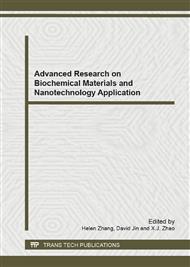[1]
S. Benchimol, A. Jothy, N. Beauchemin, K. Shirota and C.P. Stanners: Cell Vol. 57 (1989), p.327.
DOI: 10.1016/0092-8674(89)90970-7
Google Scholar
[2]
S. Oikawa, C. Inuzuka, M. Kuroki, Y. Matsuoka, G. Kosaki and H. Nakazato: Biochem. Biophys. Res, Commun. Vol. 164 (1989), p.39.
Google Scholar
[3]
R. Yuan, Y. Zhou, Y.Q. Chai, Y. Zhang and A.L. Sun: Sci. China Ser. B Vol. 50 (2007), p.97.
Google Scholar
[4]
J. Wu, J. Tang, Z. Dai, F. Yan, H. Ju and E.N. Murr: Biosens. Bioelectron. Vol. 22 (2006), p.102.
Google Scholar
[5]
A. Kokado, A. Tsuji and M. Maeda: Anal. Chim. Acta Vol. 337 (1997), p.335.
Google Scholar
[6]
Y.Y. Zhang, R. Yuan, Y.Q. Chai, Y. Xiang, X.Q. Qian and H.X. Zhang: J. Colloid Interface Sci Vol. 348 (2010), p.108.
Google Scholar
[7]
X.B. Sun and Z.F. Ma: Biosens. Bioelectron. Vol. 35 (2012), p.470.
Google Scholar
[8]
G.Z. Liu and J.J. Gooding: Electrochem. Commun. Vol. 11 (2009), p. (1982).
Google Scholar
[9]
J.P. Li, H.L. Gao, Z.Q. Chen, X.P. Wei and C.F. Yang: Anal. Chim. Acta Vol. 665 (2010), p.98.
Google Scholar
[10]
R.M. Wang, X. Chen, J. Ma and Z. F Ma: accepted by Sensors and Actuators B (2012).
Google Scholar
[11]
W.T. Shi and Z.F. Ma: Biosens. Bioelectron. Vol. 27 (2011), p.3068.
Google Scholar
[12]
N.L. Rosi and C.A. Mirkin: Chem. Rev. Vol. 105 (2005), p.1547.
Google Scholar
[13]
C. Rao, A. Sood, K. Subrahmanyam and A. Govindaraj: Angew. Chem. Int. Ed. Vol. 48 (2009), p.7752.
Google Scholar
[14]
D. Dreyer, S. Park, C. Bielawski and R. Ruoff: Chem. Soc. Rev. Vol. 39 (2010), 228.
Google Scholar
[15]
Y. Shao, J. Wang, H. Wu, J. Liu, I. Aksay and Y. Lin: Electroanalysis Vol. 22 (2010), p.1027.
Google Scholar
[16]
W. Yang, K. Ratinac, S. Ringer, P. Thordarson, J. Gooding and F. Braet: Angew. Chem. Int. Ed. Vol. 49 (2010), p.2114.
DOI: 10.1002/anie.200903463
Google Scholar
[17]
M. Dresselhau, A. Jorio, M. Hofmann, G. Dresselhaus and R. Saito: Nano Lett. Vol. 10 (2010), p.751.
Google Scholar
[18]
H. Liu, J. Gao, M.Q. Xue, N. Zhu, M.N. Zhang and T.B. Cao: Langmuir Vol. 25 (2009), p.12006.
Google Scholar
[19]
Y. Liu, M.K. Wang, F. Zhao, Z.A. Xu and S.J. Dong: Biosens. Bioelectron. Vol. 21 (2005), p.984.
Google Scholar
[20]
Z.P. Chen, Z.F. Peng, P. Zhang, X.F. Jin, J.H. Jiang, X.B. Zhang, G.L. Shen and R.Q. Yu: Talanta Vol. 72 (2007), p.1800.
Google Scholar
[21]
Z.J. Song, R. Yuan, Y.Q. Chai, B. Yin, P. Fu and J.F. Wang: Electrochim. Acta Vol. 55 (2010), p.1778.
Google Scholar



